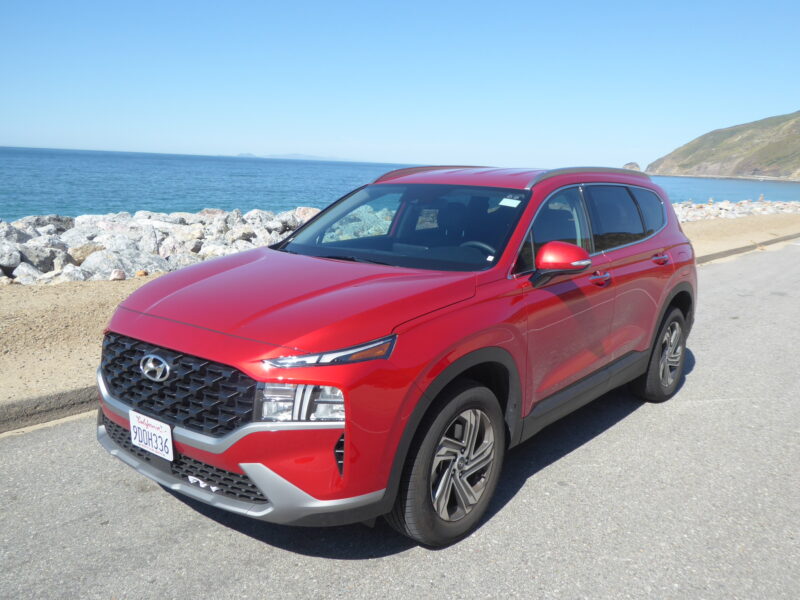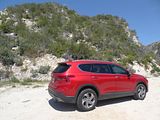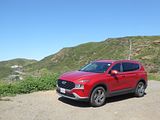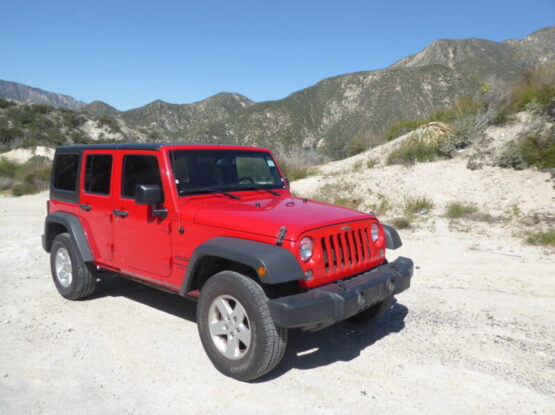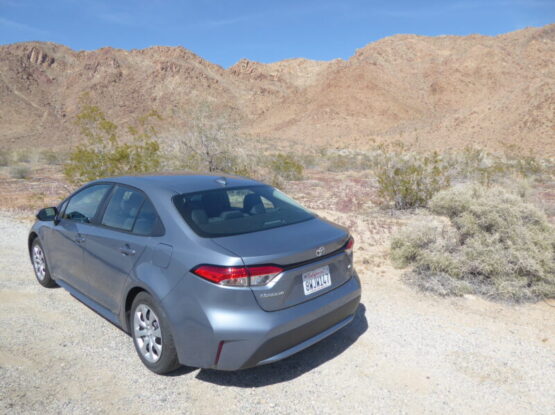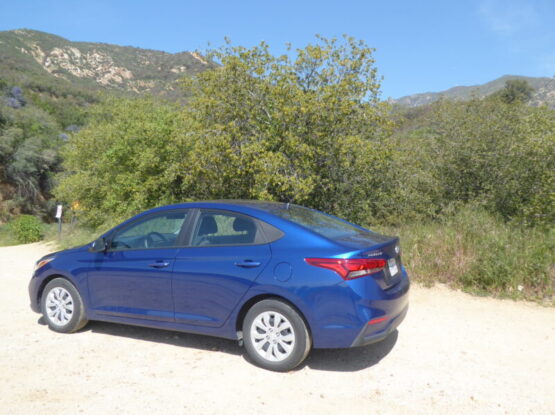Named after a city in New Mexico, the Santa Fe was introduced for the 2001 model year as Hyundai’s first SUV. The Santa Fe was a milestone in the company’s restructuring program of the late 1990s because the SUV was a hit with American buyers. The Santa Fe was initially marketed as a compact crossover SUV in its first-generation. After the Tucson was introduced in 2004, marketed under that same class, the Santa Fe was later repositioned into the mid-size crossover SUV class since its second-generation launched in 2005. Sales continued to increase, and when the third generation appeared in 2012, it was offered in two versions, one with five seats and quite a rakish rear end, which was known in the US as the Santa Fe Sport, and a seven seater with more upright back-end which took the place of the short lived Veracruz. The five seater was the version that was sold in Europe where the car was known simply as Santa Fe. It proved moderately popular in Europe, where it is perceived as a large SUV. The fourth generation car was launched in 2018, a few months after I had seen a camo-ed up version on test on the Angeles Crest Highway. Ironically, at the time I was behind the wheel of the third generation Santa Fe Sport, and as I stared at the prototype and the pictures U was able to take as the car and its rivals parked up, it was clear that the appearance would chance quite significantly. When the production car made its debut in Korea in February 2018 and a few weeks later at the 2018 Geneva Show, it did indeed look like there was more of an emphasis on practicality than style. Compared to the third-generation short-wheelbase model, the fourth-generation model was longer by 80 mm, wider by 10 mm with a 65 mm longer wheelbase. The longer wheelbase generated more legroom for passengers in the second and third row. In the second row, legroom is increased by 38 mm and the seat is 18 mm higher. Third row seats are optional in several markets, standard in some other markets and not available in regions such as North America. The fourth-generation Santa Fe was announced for the North American market at the 2018 New York International Auto Show and arrived in North American dealerships starting in mid-2018 as a 2019 model. The fourth-generation model replaced the two-row Santa Fe which was previously marketed as the Santa Fe Sport. The long-wheelbase, three-row, seven-passenger version previously marketed simply as the “Santa Fe” remained on sale for the 2019 model year as the Santa Fe XL. Its replacement, the Palisade, debuted in 2018 as a 2020 model. The new car introduced all the latest technology that you would expect. It proved popular in the US market, selling strongly. Perhaps because of the disruptions caused by the combination of Covid and the Chip Supply, few of them have appeared in the US rental fleets, so to date I had not managed to drive one. Mindful of the fact that a fifth generation car is rumoured to be only months away, I had this model high on my list of cars to try and so was pleased to spot a relatively new 2023 model year car, painted in an attractive bright red called Calypso Red, parked up at Hertz’ Los Angeles facility, and took the keys quickly before anyone else took a fancy to it.
As a 2023 model year car, this Santa Fe features the mid cycle facelift which appeared for the 2021 model year. You can tell the revised cars apart quite easily as there was a fairly obvious chance to the front with T-shaped” LED lights that merge into a newer and wider “cascading grille”. The rear has also been revised, with a long reflective strip running across the width of the car. Wider wheel arches have been engineered to accommodate the larger 20-inch wheels. Inside there is a redesigned centre stack with a shift-by-wire, push-button gear selector as well as a new drive mode selector. All bar the entry level model also have a 10.25-inch touchscreen and the driver has a 12.3-inch digital gauge cluster. In fact the changes were rather more far-reaching than this as the facelifted Santa Fe is stated to be built on a newer N3 platform, allowing hybrid and plug-in hybrid models to be offered. With the new platform, Hyundai claimed an expanded use of high-tensile steels in its body structure, while undercovers for the subframe, engine compartment, and cabin floors results in an improvement of the coefficient of drag from 0.34 to 0.33. The entry level engine was changed, too, with a 2.5 litre Smartstream unit replacing the earlier 2.4 litre 4 cylinder. Not having tested the early version of the fourth generation Santa Fe, I can’t tell just how much of a difference these changes have made, but I was going to be able to tell from the day ahead how good this Santa Fe and how it stacks up in a very competitive market segment.
In the US, there is a choice of two different engines, both of them four cylinder units. The test car, being an SEL, had the 191 bhp four cylinder 2.5 litre engine, connected to an eight speed automatic transmission and front wheel drive. Although this is quite a large car, the engine seemed well up to the task in hand and the Santa Fe had good levels of acceleration from pretty much any speed. More impressive, perhaps, was how smooth and refined it all felt, with noise levels at low levels at all times, thanks in no small part to dual-pane front windows and comprehensive sound-deadening. There is a push button gear selector with wheel mounted paddles also featuring. I covered 216 miles in my day with this Hyundai and it needed 6.6 gallons to fill it, which works out at a commendable 32.73 mpg US or 39.1 mpg Imperial, which I thought was good for such a large car.
Although lacking the sort of set-up that makes a Mazda or a Ford so good to drive, even in SUV format, the Santa Fe is not bad and has to rank as one of the more enjoyable cars to drive in its class. The steering is well weighted. It is pretty light in the straight-ahead position, as so many cars are these days, but there is more weight and more feel as you turn the wheel, and the result of this set-up, of course, is that the Santa Fe is easy to manoeuvre. It is quite a large car with an SUV-like centre of gravity, so handling is never going to be as good as in a saloon, but again, among its class rivals, this is one of the better ones. There is ample grip and the car does not roll unduly on tighter corners. The ride is well judged, coping with the varied surfaces of the Southern Californian roads so it always felt comfortable without being overly soft. This version of the Santa Fe comes on 235/60 R18 wheels. The brakes worked well, and I did test them on some of the steeper canyon roads where they got quite a good work out. There is an electronic parking brake and this sets when you put the car into Park, as is the case with pretty much all cars these days. However, it will not release unless the seat belt is fastened, which I found more than a little irksome when I was moving the car around doing photos. Visibility is generally good and a Blind Spot Warning system is one of the many ADAS features included. You also get the loathsome Lane Keep Assist, but fortunately, this is easy to turn off.
The interior of the Santa Fe is nicely finished, using plenty of good quality materials. There is a weave effect inlay on the centre console and you get a leather-wrapped steering wheel which proved pleasant to hold. As well as looking good, it also proved easy to use. There is a simple instrument binnacle with two large dials for speedometer and rev counter with smaller fuel level and water temperature inset in the lower portions of the larger dials. Between them is a trip computer display area. There are two chunky column stalks which include the lights which have an auto function. There are plenty of buttons on the steering wheel hub for cruise control, audio repeaters and to cycle through the trip computer. The 10.25” infotainment screen is set up high on the dash where it is easy to see, but perhaps a bit of a stretch to reach. It has a touch interface and there are also ample buttons set lower in the dash in an area that swoops down into the centre console. Functions on the screen include XM Satellite radio and navigation as well as wired Apple Car Play and Android Auto. The graphics on the screen were particularly clear and the system was nicely responsive. Lower down the console area are buttons for the dual zone climate control.
Continuing the good impression set by the dashboard, the seats are trimmed in a nice quality cloth. The one for the driver is 8-way electrically adjustable, including lumbar support, and there are height adjustable seat belts as well as a steering column which telescopes in/out as well as up/down, making it easy to get the optimum driving position. There is a real feeling of space here, with the SUV styling endowing the car with a lot of headroom. The standard spec includes heated seats.
There is also lots of space in the back. Even with the front seats set well back, there is ample legroom, and headroom is generous as you might expect from an SUV. The backrest angle is adjustable. There is a drop-down central armrest with cupholders in the upper surface, and passengers here also get a pair of USB ports, their own air vents, map pockets on the back of the front seats and bins on the doors.
The boot is a good size. Access is easy, as the tailgate is large, which also means that it is quite heavy but thankfully there is electrical assistance here to close it. There is a false floor with plenty of space underneath, not least because there is no spare wheel. The rear seat backrests, which are asymmetrically split, simply drop down to create a long and flat load platform. I was slightly surprised to find that you don’t get a load cover in this version of the Santa Fe. There are plenty of places for odds and ends in the passenger compartment. A good-sized glovebox is supplemented with the usual door pockets and central armrest cubby and there is also a lipped shelf above the glovebox and a useful space under the centre console.
On the US market, the 2023 Hyundai Santa Fe is available in five trims: SE, SEL, XRT, Limited and Calligraphy. The first three trims come with a 191 bhp four-cylinder engine, an eight-speed automatic transmission and front-wheel drive. If you want more oomph, consider the Limited or Calligraphy trims, which come with an upgraded 281 bhp turbo-four and an eight-speed dual-clutch automatic transmission. When the SUV was new, all-wheel drive was a $1,700 option in every trim. Standard features in the SE trim include an 8-inch touch screen with wireless Apple CarPlay and Android Auto, Bluetooth, four USB ports, HD Radio, cloth upholstery, manually adjustable front seats and 18-inch alloy wheels. A wealth of safety features also come standard, such as a rearview camera, blind-spot monitoring, rear cross-traffic alert, LED headlights with automatic high beams, forward collision warning, forward automatic emergency braking, pedestrian detection, adaptive cruise control, lane-keep assist, lane-following assist, driver-attention monitoring, a rear-seat alert and safe-exit assist. The SEL trim features gains a 10.25-inch touch screen with wired Apple CarPlay and Android Auto, navigation, wireless device charging, heated front seats, an eight-way power-adjustable driver’s seat, heated side mirrors, dual-zone automatic climate control, a digital key, proximity keyless entry, push-button start, Highway Driving Assist, a hands-free liftgate and roof rails. The Premium package adds a 12-speaker Harman Kardon premium audio system, a 12.3-inch digital gauge cluster, an eight-way power-adjustable front passenger seat, power-folding rear seats, a panoramic sunroof, chrome exterior accents, an auto-dimming rearview mirror, a blind-spot camera and a surround-view camera system. The XRT trim adds side steps, black interior and exterior accents and trim-specific styling. In addition to the stronger engine, the Limited trim gains the contents of the SEL Premium package, as well as leather upholstery, ventilated front seats, heated rear seats, a heated steering wheel, front and rear parking sensors, Remote Smart Parking Assist, a surround-view camera system and 19-inch wheels. The Calligraphy trim gains quilted Nappa leather upholstery, a head-up display and 20-inch wheels.
This Santa Fe struck me as just about the perfect family car. There’s lots of space for people and luggage with a roomy passenger compartment, a good boot and ample provisions for odds and ends. The interior is neatly presented and nicely finished. Theis Hyundai is decent to drive, and proved particularly economical, and in SEL trim there is a good level of equipment. Hyundai models in the US come with one of the most generous warranties on offer and the car is well priced. There is an awful lot to like and very little to complain about. For sure, it is not particularly exciting, but that was not really the design intent. The Santa Fe has lots of rivals, and you will find almost all of them parked up in the rental car lots, as this is one of the most sought after categories of car for people to rent. I’ve driven most of them, and would say that if faced with a line of them all, the Santa Fe is probably the car I would currently select.

